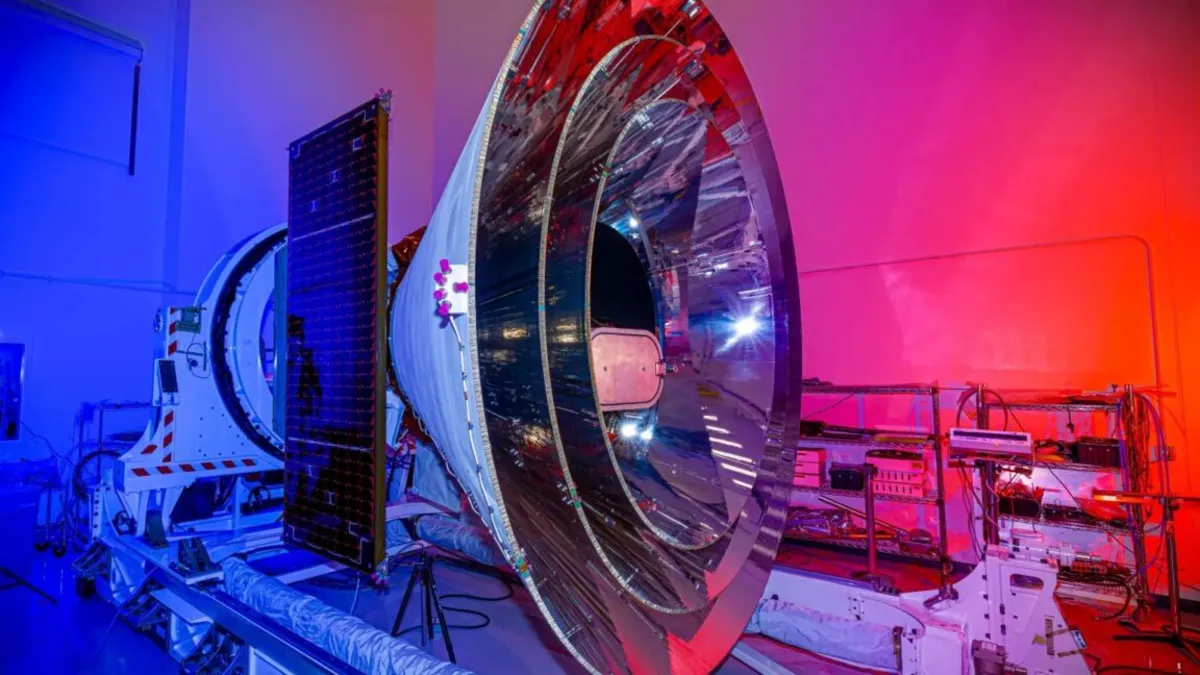
NASA's latest endeavor, the SPHEREx mission, is unlike any other satellite currently orbiting Earth. This innovative infrared observatory was successfully launched aboard a SpaceX Falcon 9 rocket on Tuesday night from Vandenberg Space Force Base in California, at precisely 8:10 PM local time (11:10 PM EDT). Less than 45 minutes post-launch, SPHEREx was deployed into a polar orbit approximately 420 miles (675 kilometers) above Earth. Ground controllers quickly confirmed the health of the spacecraft upon receiving its first signals from space.
In the coming month, engineers will verify SPHEREx's readiness to commence its ambitious two-year science mission. The observatory is set to survey the night sky in an astonishing 102 colors that are not visible to the human eye. Equipped with advanced infrared detectors, SPHEREx will gather crucial data regarding the chemical compositions of asteroids, star-forming clouds, and distant galaxies. The mission is expected to generate an extensive three-dimensional map of the entire night sky, addressing fundamental questions in the field of astrophysics.
According to Phil Korngut, the mission's instrument scientist at Caltech, "Using a technique called linear variable filter spectroscopy, we're going to produce 102 maps in 102 wavelengths every six months. Our baseline mission is to do this four times over the course of two years."
The name SPHEREx is an abbreviation for the Spectro-Photometer for the History of the Universe, Epoch of Reionization, and Ices Explorer. This $488 million mission seeks to provide answers to three fundamental questions: How did the Universe begin? How did galaxies form? What conditions are necessary for life beyond our Solar System?While these goals can be succinctly summarized, they delve into complex topics such as cosmic inflation, quantum physics, and the flatness of spacetime, making the inquiry both scientific and philosophical in nature.
Constructed by BAE Systems, SPHEREx is roughly the size of a subcompact car. While it lacks the power and resolution of flagship observatories like the James Webb Space Telescope, it offers unique advantages. Unlike Webb, which focuses on small sections of the sky, SPHEREx is designed to observe the cosmos in all directions, capturing a comprehensive spherical view. This capability allows SPHEREx to perform infrared spectroscopy on hundreds of thousands of objects simultaneously, conducting over 600 exposures every day.
SPHEREx's innovative design features three concentric photon shields that insulate its optics and detectors from heat and light, a simpler solution compared to the complex sunshield used by Webb. This design eliminates moving parts, enhancing the mission's reliability and longevity.
SPHEREx aims to explore the concept of cosmic inflation, which theorizes that the Universe experienced a rapid expansion just after the Big Bang nearly 13.8 billion years ago. This expansion, according to scientists, left behind a blueprint for the Universe's large-scale structures, termed the cosmic web. Jamie Bock, a cosmologist at Caltech, explains that while inflation theory has been consistent with observational data, the exact causes remain elusive. "SPHEREx will test various models of inflation by mapping hundreds of millions of galaxies across the entire sky," Bock states.
The telescope will also collect light emitted by all galaxies, reaching back to the cosmic dawn, when the first stars and galaxies emerged from the foggy aftermath of the Big Bang. This novel approach will enable scientists to study cosmic history in a way that has not been achieved before.
In addition to its broader cosmic studies, SPHEREx will focus on our own galaxy, investigating water and ice in molecular clouds—critical components in the formation of stars and planets. According to Rachel Akeson, the SPHEREx science data center lead at Caltech, "Most of the water and ice in the Universe is likely located in these molecular clouds." SPHEREx's observations are expected to provide data on over 9 million targets, significantly expanding our understanding of water's role in the potential for life beyond Earth.
Alongside SPHEREx, a second NASA mission named PUNCH was launched into a similar orbit shortly after. This mission consists of four small satellites designed to study the solar corona, the Sun's outer atmosphere. The $150 million PUNCH mission aims to uncover how the solar corona generates the solar wind, a continuous stream of charged particles emitted by the Sun.
Understanding the solar wind is critical due to its interactions with Earth's magnetic field, which can lead to geomagnetic storms affecting satellite operations, navigation, and communication. PUNCH will utilize the combined imaging capabilities of its four satellites to monitor solar wind as it travels through the Solar System.
Launching multiple missions simultaneously, like SPHEREx and PUNCH, is a cost-effective strategy for NASA, allowing for more efficient use of resources. By sharing a launch, NASA can significantly reduce costs. For instance, launching PUNCH independently would have required at least $15 million, a substantial saving that underscores NASA's commitment to maximizing science return on investment.
Mark Clampin, acting deputy administrator for NASA's Science Mission Directorate, emphasizes this new approach, stating, "It's a new strategy that SMD is working on to maximize the efficiency of launches by flying two payloads at once." This collaborative approach highlights NASA's dedication to pioneering scientific exploration while managing costs effectively.